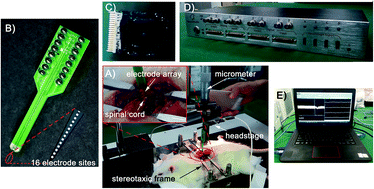Effects of the electrode insertion depth on the neural signal amplitude in the spinal cord
Abstract
The technique used for electrode insertion navigation is of crucial importance for neural signal collection. The spinal cord mapping method tracks the placement of electrodes throughout their insertion trajectory in vivo, allowing high accuracy for electrode insertion guidance with micrometer step resolution, but is time consuming. In the present study, we used the spinal cord mapping method to collect pain signals from the rat spinal cord. We found that the amplitude of the neural signal was approximately inversely proportional to the electrode insertion depth when the electrode was more than 30 μm away from the target neurons, and was approximately proportional to the square of the electrode insertion depth when the electrode was close to the target neurons. Based on this relationship, the amplitude of the collected neural signal can be used to determine the electrode placement to reduce time consumption for electrode positioning.



 Please wait while we load your content...
Please wait while we load your content...